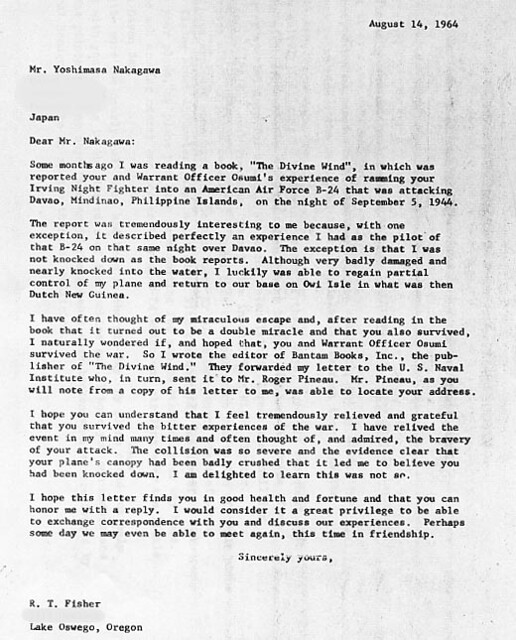This story is one of our favorites and we thought it was time to reblog it. Without further ado, here is the tale of an unlikely friendship between two veteran World War II pilots.
Two 63rd Squadron B-24 Snoopers took off from Owi Island on the night of September 4, 1944 to bomb Matina Airdome at Davao, Mindinao. One of the B-24s soon turned back due to radar failure. Captain Roland T. Fisher, pilot of the other B-24, “MISS LIBERTY,” continued on alone. Fisher had flown night missions with the Royal Air Force in 1941 and would soon be needing every ounce of skill he had acquired over the last few years.
Twenty-one years after this mission, Fisher recounted his experience: “I could see again the bright moon in the clear night sky and the green shadow of Cape San Agustin below. I had entered Davao Gulf by crossing from the Pacific over the peninsula into the head of the gulf and made nearly a straight-on approach over Samal Isle to Matina air strip. I remember thinking perhaps this would allow me to enter the gulf undetected. On previous occasions I had entered the gulf at the mouth and flew north, and it seemed like [Japanese] defenses always spotted me.
“But this evening my plan didn’t work…I recall vividly being in the searchlights and how, just after I had made the bomb run over the air base, I made a sharp turn to the left with the intent of flying south out of the bay.” Back on the Japanese-held base, a man who had been ordered to reconnoiter the area in his Irving night fighter spotted the interloper. That man was Yoshimasa Nakagawa. “Some minutes after my plane took off,” wrote Nakagawa, “I found that the bomb which had fallen off [the B-24] seemed to have been exploded somewhere in the air-base. My plane had caught sight of [the B-24] which was flying about 1500 meters high above mine…my plane had been kept waiting for [him] to start on [his] way home. My plane was drawing nearer and nearer to [his] B-24 which was circling over the little island in Davao Bay.”
While Fisher was still in the middle of his turn out of the bay, Nakagawa flew straight at “MISS LIBERTY” with guns blazing. A collision between the two planes was imminent and Fisher pulled up a wing, narrowly avoiding the Japanese fighter. Nakagawa turned again to make another attack on Fisher’s B-24, this time for the death. “My plane could not help colliding with [the B-24] owing to the disorder of the machine gun. I hope you can understand we Japanese pilots of those days felt as if their heart were broken when we were forced by the General Headquarters to do such a thing as collision,” he later wrote. As Nakagawa rammed his plane into the B-24, his fighter’s propellers severely damaged the belly of the B-24.
When the planes broke apart, Nakagawa watched Fisher’s plane plunge towards the sea and flew to base thinking about the skill of the American pilot, who probably wouldn’t make it home. Fortunately, Fisher was able to limp back to Owi after a long, tense 7 hour flight. Years later, Nakagawa contributed to a book called The Divine Wind, which is about experiences of kamikaze pilots. In that book was the story of his encounter with that B-24. Fisher received a copy of the book from a former tentmate, telling him to look on page 29, where he found the mission described above. He then composed the following letter:
Even though Nakagawa had tried to kill Fisher and his crew years ago, the two men put the past behind them and struck up a friendship 20 years after their first encounter. The men met in 1972, both of them thankful that the other was still alive, and appeared on the Dick Cavett television show together. “Imagining how bravely you could survive the World War 2 that had made the horrible marks in the history of the slaughter of human race,” Nakagawa wrote to Fisher. “I am inclined to heartily express my joy that you are still living all right. I am very grateful to you, who hope I am in good health and fortune, for the fact that you have no antipathy against me, who had once been an enemy of you. I am also very much delighted to be able to exchange correspondence with you. I hope you are in good health and happy for ever.”
In his response to Nakagawa, Fisher wrote, “Then you and I were young and conducted ourselves as young men should for our countries. Now we are older an wiser and our countries are wiser and I feel that we have attained a lasting friendship between our countries that is not only honorable but sensible and good for their futures. Still those dark moments we spent as young men in the night tropic skies of twenty years ago, I am sure, always will be glistening memories no matter how old we grow.”



A wonderful story. Both men have learnt so much.
LikeLike
Always great to read… However, I am sad to feel such friendships will not arise from our war on terrorism.
LikeLike
Reblogged this on Masako and Spam Musubi.
LikeLike
It is indeed a beautiful story, Koji. The last paragraph, in particular, is really moving. I’m glad you shared it…again! And I enjoyed seeing your winning photograph in the recent edition of “Westways Magazine.” Job well done!
LikeLike
A fabulous story. It’s good that reconciliation and friendship can grow from the depths of such horrors as the Second World War.
LikeLike
Pingback: Repost: Friendship After Bombing Davao | Meccanica Mekaniikka Mecanică